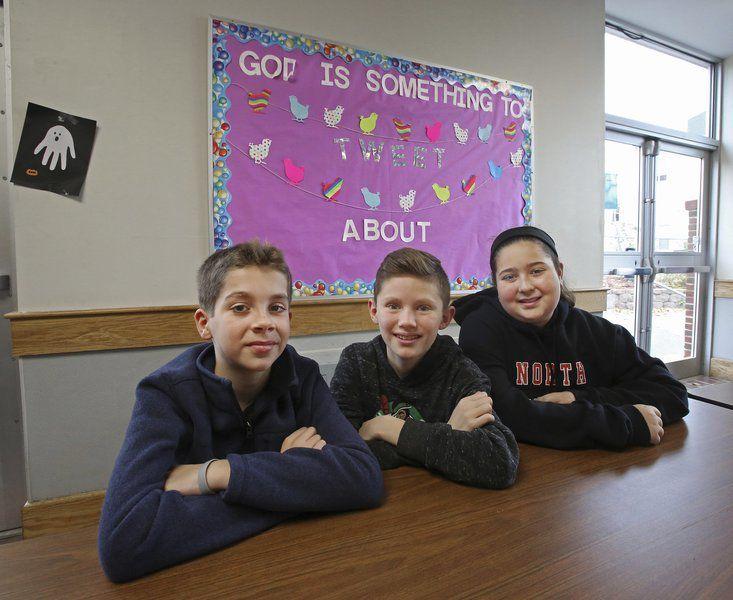
[ad_1]
NORTH ANDOVER — These days, many people look forward to Halloween.
Traditionally, it was the younger set who enjoyed dressing up in costumes and going trick-or-treating, but lately adults have joined the fun in larger numbers.
So what was the origin of this annual festival?
Many if not most folks know that Halloween derives from Hallowe’en, which comes from All Hallows Eve. The hallows, or saints, are honored by the Catholic Church on Nov. 1. The Anglican Communion and some other Protestant denominations also celebrate the Feast of All Saints.
It’s been around for many years. Pope Gregory III established Nov. 1 as the day to honor all saints in the 700s. For Catholics, it’s a holy day of obligation, during which they are required to attend Mass. They are not only supposed to go to church that day, they are also expected to strive to be saints.
“We’re all called to holiness,” says Earline Tweedie, director of campus ministry at Central Catholic High School in Lawrence.
Dictionaries generally define a saint as a very holy person, someone who has lived a pious life and been charitable to others. In the Catholic tradition, the church has determined that certain people throughout the ages have lived such holy lives that they are residing in heaven and can intercede for mortals who pray to them.
The church requires miracles as proof of someone being a saint. One miracle leads to beatification, while a second one must be approved by the church for a person to be canonized and worthy of the title saint.
A few students at Catholic schools in the area were recently asked about the meaning of this day, which has such a longtime connection to the festival of trick or treating.
“They’re not against one another,” Maria Graziano, of Atkinson, New Hampshire, a senior at Central Catholic, said about these two days.
She noted some Catholic schools stage All Saints Day parties, at which students dress up as saints rather than goblins, vampires, monsters or whatever. St. Michael School in North Andover did that a few years ago.
Graziano called All Saints “a really important feast,” but “it often gets overlooked,” she added.
She admires two saints in particular, St. Bernadette Soubirous, the French peasant girl who claimed she was visited by the Blessed Mother in 1858; and St. Catherine of Siena, now recognized as a doctor of the church.
“People thought she was insane,” she said of St. Bernadette. Despite vigorous interrogation by ecclesiastical and civil authorities, Bernadette persevered, insisting that a “lady” spoke to her and asked that a chapel be constructed at the site of the apparitions in Lourdes.
The chapel was built and today the shrine at Lourdes is one of the most popular in the world.
St. Catherine of Siena defended the authority of the pope in the 14th century.
“She knew that what she was doing was right,” said Graziano, who suggested St. Catherine of Siena’s courage and perseverance are a model for women today.
Graziano pointed out that the vast majority of saints are not canonized. There are many people who have a holy presence, she noted.
“My grandmother was definitely in that category,” she said. Graziano was only 6 years old when Eleanor Bercume died, but she knew her grandmother was “someone I wanted to imitate.”
“She prayed the rosary every day and was very kind and accepting,” Graziano recalled.
This honors student, who takes advanced placement classes in English, biology, calculus, chemistry and psychology and aspires to be a neurologist, has a friend whom she thinks might be on the road to sainthood.
This friend has faced some hard times, but “she is one of the kindest people I know,” Graziano said. “She always tries to make everybody else better.”
At St. Michael School in North Andover, three sixth-graders, Meredith Rhodes, Keegan Paradis and Harrison Miller, said Wednesday they were looking forward to trick or treating that night. Meredith planned to dress up like a vampire, Keegan was all set to wear a Ferris Bueller outfit and Harrison said he was going to be “an old-fashioned football player.”
Nevertheless, all three understood the meaning of the Feast of All Saints. Saints are people who “sacrificed for God,” Keegan said.
“They trusted in God no matter what,” Harrison added.
The saints are also “your loved ones who are in heaven,” Meredith said.
Keegan’s favorite saint is St. Patrick “because I am part Irish,” he explained. He noted that St. Patrick brought Christianity to Ireland.
Meredith said Saints Lucy and Cecilia are her favorites. Lucy was a martyr in the third century while Cecilia is the patron saint of music. Meredith, who plays the flute, ukulele and piano, said she and her family are “wrapped around music.” Harrison said he admires St. Paul because the writer of all those epistles “taught everyone about God.”
Source link